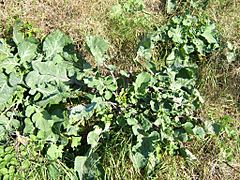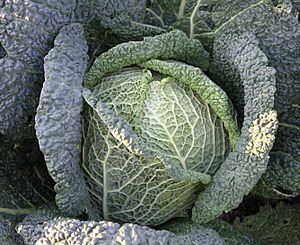Cabbage facts for kids
Quick facts for kids Brassica oleracea |
|
|---|---|
 |
|
| Wild Cabbage plants | |
| Scientific classification | |
| Kingdom: | |
| Division: | |
| Class: | |
| Order: | |
| Family: | |
| Genus: | |
| Species: |
B. oleracea
|
| Binomial name | |
| Brassica oleracea |
|
Cabbage is a popular leafy green or purple vegetable. It grows a big, round head of tightly packed leaves. Cabbage is related to other veggies like broccoli, cauliflower, and Brussels sprouts. These are all part of the same plant family.
Cabbage heads usually weigh between 0.5 to 4 kilograms (1 to 9 pounds). They can be green, red, or even white. The most common type is a smooth, firm green cabbage. Red and crinkly-leafed savoy cabbages are also grown.
People probably started growing cabbage in Europe over 3,000 years ago. By the Middle Ages, it was a very important food in Europe. Cabbage heads are usually picked in the plant's first year. If you want to collect seeds, the plant grows for a second year.
In 2014, countries around the world grew about 71.8 million metric tons of cabbage. China grew almost half of all the cabbage in the world!
Cabbage can be eaten in many ways. You can pickle it, ferment it into dishes like sauerkraut, steam it, or eat it raw. Cabbage is good for you because it has lots of vitamin K, vitamin C, and dietary fiber.
Contents
How We Use Cabbage
The part of the cabbage plant we usually eat is the big, round head. This head is made of many layers of young leaves.
Eating Cabbage Raw
Raw cabbage is often cut into thin strips or shredded. It's great in salads, like coleslaw. You can also use shredded cabbage instead of lettuce in sandwiches.
Cooking Cabbage
Cabbage is often added to soups or stews. Cabbage soup is very popular in central and eastern Europe. It's also an ingredient in some kinds of borscht. Many dishes in India use cabbage too.
When you boil cabbage, the leaves become soft. This also releases a special "cabbage" smell. In some places, boiled cabbage is known for its strong smell. Cooked cabbage is a good way to get vitamins and dietary fiber.
Cabbage rolls are a tasty dish from Eastern Europe and the Middle East. The leaves are softened, then filled with chopped meat or rice.
Fermented and Preserved Cabbage
Cabbage is used to make sauerkraut in Germany. It's also used for suan cai in China and kimchi in Korea. To make pickled cabbage, it's put in a jar with water and salt. It then sits in a warm place for a few days to ferment.
Historically, people made large amounts of sauerkraut at home. This was a way to store food for the winter. Cabbage can also be pickled in vinegar with different spices.
Cabbage and Your Health
Cabbage is an excellent source of Vitamin C. This vitamin helps your body stay healthy. It also has something called glutamine. This is an amino acid that can help reduce swelling in the body.
Different Kinds of Cabbage
There are many types of cabbage. They come in different shapes and ripen at different times. Some common types include "Late Flat Dutch" and "Early Jersey Wakefield." "Danish Ballhead" is a round-headed type that ripens later.
Savoy Cabbage has a round head with crinkly leaves. Red cabbage is a smaller, round type with dark red leaves. Krautman is a common type grown for making sauerkraut.
Growing Cabbage

Cabbage types are generally divided into two groups: early and late. Early varieties grow quickly, in about 45 days. They make small heads that are best eaten fresh. Late cabbage takes longer, about 87 days, and grows larger heads.
You can start cabbage seeds indoors or plant them directly outside. Cabbage grows best in cool weather. So, planting it early or late in the season is better than during the hot summer.
It's important to protect cabbage plants from insects. Caterpillars of some butterflies, like the "whites," love to eat cabbage leaves. Farmers sometimes use special sprays to keep these pests away.
Before refrigerators were common, cabbage was a popular winter vegetable. This is because it stores well for a long time.
Today, China grows the most cabbage in the world. India and Russia also grow a lot of cabbage.
Cabbage's Plant Relatives
The Brassica oleracea plant species has many different types. These are known by other names, even though they are all related to cabbage. Some of these include:
- Broccoli: Its flower clusters are eaten.
- Brussels sprouts: These are small, green heads that look like tiny cabbages.
- Chinese kale or Chinese broccoli: Another leafy green.
- Cauliflower: Like broccoli, its flower cluster is eaten.
- Kale or spring greens: This type has curly leaves that don't form a tight head. Some people think it's the original form of cultivated cabbage.
- Collard greens: A type of kale.
- Kohlrabi: This plant has an edible stem that grows large and turnip-shaped.
There are also some mixed types, called hybrids. These include broccolini (a mix of broccoli and Chinese kale) and broccoflower (a mix of broccoli and cauliflower).
Two types of Chinese cabbage from Asia also look a bit like cabbage. They are often used as greens:
- Brassica chinensis, also called bok choy or celery cabbage. It forms loose heads of dark green leaves.
- Brassica pekinensis, or pe-tsai. This one forms a long, compact head of light green leaves.
Other Plants Called "Cabbage"
Many other plants are called "cabbage" because of how they look. However, most of these are not food plants that people eat.
Some palm trees are called cabbage palm or cabbage tree. Their young buds are sometimes eaten like cabbage. Examples include the assai palm and the cabbage palmetto.
Other plants with "cabbage" in their name include:
- Cabbage rose: A fragrant garden rose with full white or pink flowers.
- Head lettuce: Its leaves grow in a tight circle, forming a head like cabbage.
- Kerguelen cabbage: A plant from an island in the Indian Ocean.
- Skunk cabbage: This plant has a strong smell, like a skunk.
- Wild cabbage: A plant with edible leaves.
- Sea-otter's-cabbage: A type of brown seaweed.
Images for kids
-
The cabbage inflorescence, which appears in the plant's second year of growth, features white or yellow flowers, each with four perpendicularly arranged petals.
-
Cabbage moth damage to a savoy cabbage
See also
 In Spanish: Repollo para niños
In Spanish: Repollo para niños









